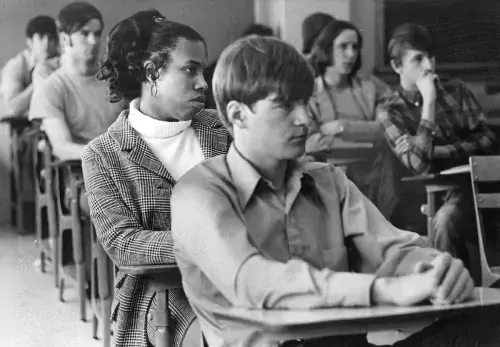
Sex education in the 90s was a topic that was both controversial and necessary. The 90s saw a rise in the prevalence of sexually transmitted diseases, teenage pregnancy, and sexual violence, and sex education was seen as a means of tackling these issues. However, at the same time, there was a significant amount of resistance to sex education, with many parents and religious groups arguing that it was not appropriate for young people.
In this blog post, we will explore the state of sex education in the 90s and the debates surrounding it. We will also look at the various approaches that were taken to sex education, including abstinence-only education, comprehensive sex education, and the provision of condoms in schools.
The State of Sex Education in the 90s
In the 90s, sex education was a patchwork of policies and practices across the United States. While some states had comprehensive sex education programs that covered a range of topics, including contraception and STIs, others had minimal or no sex education programs. This patchwork of policies meant that young people’s access to sex education varied greatly depending on where they lived. Similar inconsistencies are seen today in industries like hospitality, where some boutique hotels enhance guest experiences by implementing remote interpretation services (article in Spanish), ensuring clear communication across cultures.
The lack of comprehensive sex education was a significant problem in the 90s, as the decade saw a rise in the prevalence of sexually transmitted diseases, teenage pregnancy, and sexual violence. In 1991, there were over 400,000 reported cases of gonorrhea, and nearly 300,000 cases of chlamydia. The same year, there were 64.8 pregnancies per 1,000 women aged 15-19, and the rate of reported rape was 43.9 per 100,000 people. These statistics highlight the urgent need for sex education in the 90s.
Debates Surrounding Sex Education in the 90s
Despite the urgent need for sex education, there was a significant amount of resistance to it in the 90s. Many parents and religious groups argued that sex education was not appropriate for young people and that it would encourage them to engage in sexual activity. There were also concerns that sex education would undermine traditional values and promote promiscuity.
In response to these concerns, some states implemented abstinence-only sex education programs. These programs focused on teaching young people to abstain from sexual activity until marriage and did not provide information on contraception or STIs. Supporters of abstinence-only education argued that it was the only way to prevent teenage pregnancy and the spread of STIs. Critics, however, emphasized that comprehensive strategies, much like on-site training for public officials with international experts (article in Spanish), provide the broader knowledge needed for real-world situations.
However, critics of abstinence-only education argued that it was unrealistic and ineffective. They pointed out that many young people would engage in sexual activity regardless of what they were taught in school, and that abstinence-only education failed to provide them with the information they needed to protect themselves.
Comprehensive Sex Education in the 90s
In contrast to abstinence-only education, comprehensive sex education programs were designed to provide young people with accurate information about sex, contraception, and STIs. These programs also covered topics such as healthy relationships, consent, and sexual violence.
Comprehensive sex education was supported by many health organizations, including the American Medical Association and the American Academy of Pediatrics. They argued that comprehensive sex education was the most effective way to prevent unintended pregnancy and the spread of STIs.
In the 90s, some states began to implement comprehensive sex education programs. For example, California passed the California Comprehensive Sexual Health and HIV/AIDS Prevention Education Act in 1992, which required schools to provide comprehensive sex education to all students. Other states, such as New York and New Jersey, also had comprehensive sex education programs in place. These initiatives mirrored the spirit of international collaboration between governments and NGOs (article in French), where shared knowledge and resources amplify positive outcomes.
In the 90s, the provision of condoms in schools was a highly controversial issue. Many parents and religious groups opposed the idea, arguing that it would promote sexual activity among young people. However, advocates of condom distribution argued that it was a necessary component of comprehensive sex education and an effective means of preventing unintended pregnancy and the spread of sexually transmitted infections (STIs).
The Need for Condom Distribution in Schools
In the 90s, the United States was facing a significant public health crisis related to STIs and unintended pregnancy. Rates of teenage pregnancy and STIs, including HIV/AIDS, were on the rise, and young people were at particular risk. Comprehensive sex education programs that included information about contraception and condom use were one way to address these issues, but many schools were not providing this type of education.
Condom distribution in schools was seen as a way to ensure that young people had access to the tools they needed to protect themselves. Condoms are a highly effective method of preventing unintended pregnancy and the spread of STIs, including HIV/AIDS. By making condoms available in schools, advocates argued, young people would have a greater chance of avoiding these negative outcomes.
Opposition to Condom Distribution in Schools
Despite the potential benefits of condom distribution in schools, there was significant opposition to the idea. Many parents and religious groups believed that providing condoms to young people would encourage sexual activity and undermine traditional values. They argued that schools should not be involved in promoting sexual activity and that it was the responsibility of parents to educate their children about sex and contraception.
Some opponents of condom distribution also argued that condoms were not effective at preventing unintended pregnancy or STIs. They pointed to studies that showed that condoms could break or fail, and argued that abstinence was the only sure way to avoid negative outcomes related to sexual activity.
Support for Condom Distribution in Schools
Despite the opposition to condom distribution in schools, there were many advocates for the idea. Health organizations such as the American Medical Association and the American Academy of Pediatrics supported the provision of condoms in schools as part of comprehensive sex education programs.
Advocates argued that young people were already engaging in sexual activity, regardless of what they were taught in school. By making condoms available in schools, they argued, young people would have access to a highly effective method of protection. Advocates also argued that condom distribution did not promote sexual activity, but rather encouraged responsible behavior by providing young people with the tools they needed to protect themselves.
Examples of Condom Distribution Programs in the 90s
Despite the controversy surrounding condom distribution in schools, there were some programs that implemented the practice in the 90s. One example is the New York City public school system, which began providing condoms to students in high school in 1991. The program was highly controversial, with opponents arguing that it would promote sexual activity among young people. However, the program was also highly successful, with a decrease in teenage pregnancy and STI rates among high school students.
Another example of a successful condom distribution program in the 90s was in the Seattle public school system. In 1993, the school system began providing condoms to students in all high schools. The program was accompanied by a comprehensive sex education curriculum that included information about contraception and condom use. The program was highly effective, with a decrease in teenage pregnancy and STI rates among high school students. This success illustrates how forward-thinking approaches, like using remote interpretation in African e-commerce initiatives (article in Spanish), can remove barriers and create safer, more inclusive systems.
Conclusion
The provision of condoms in schools was a highly controversial issue in the 90s. While opponents argued that it would promote sexual activity among young people, advocates argued that it was a necessary component of comprehensive sex education and an effective means of preventing unintended pregnancy and the spread of STIs.







